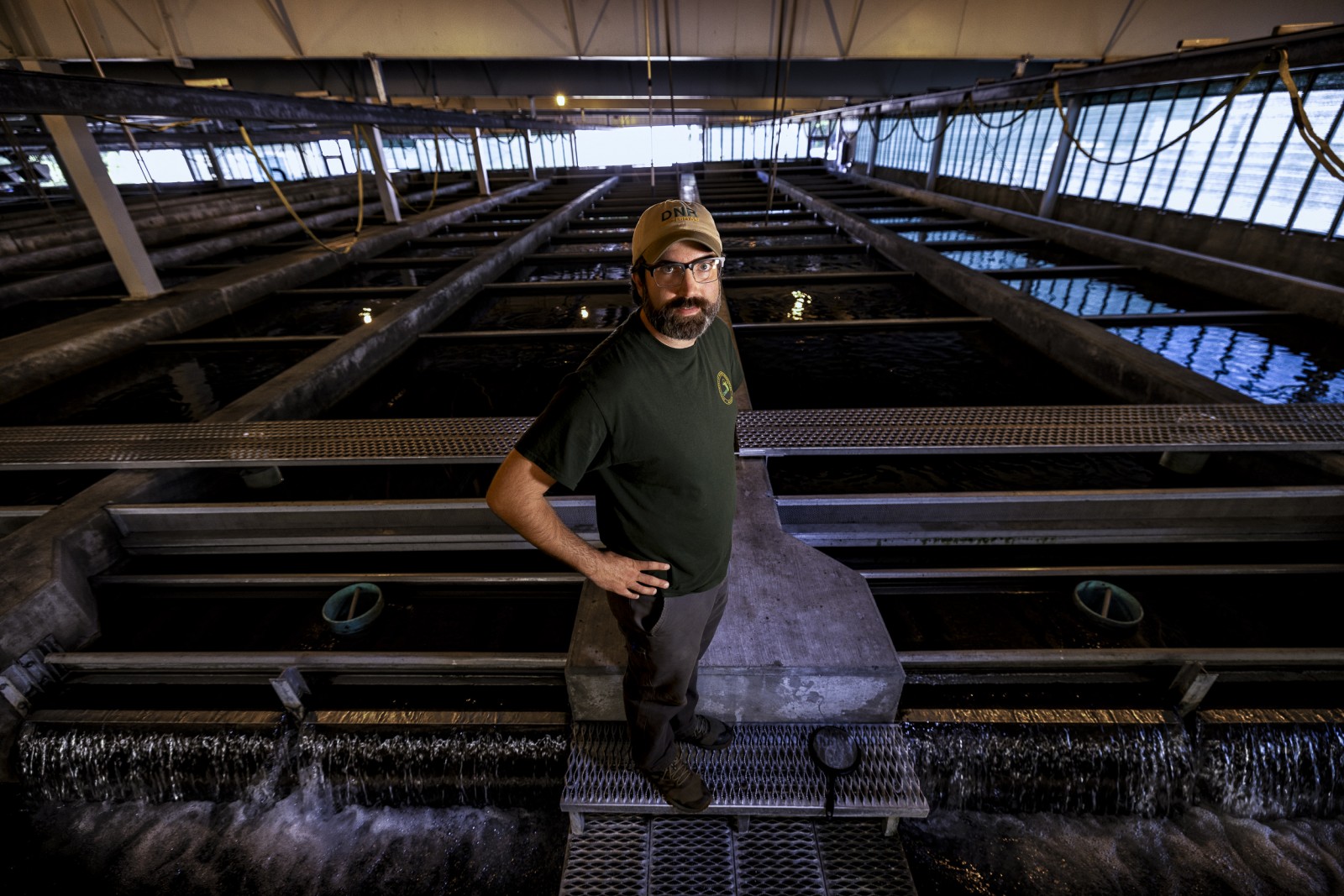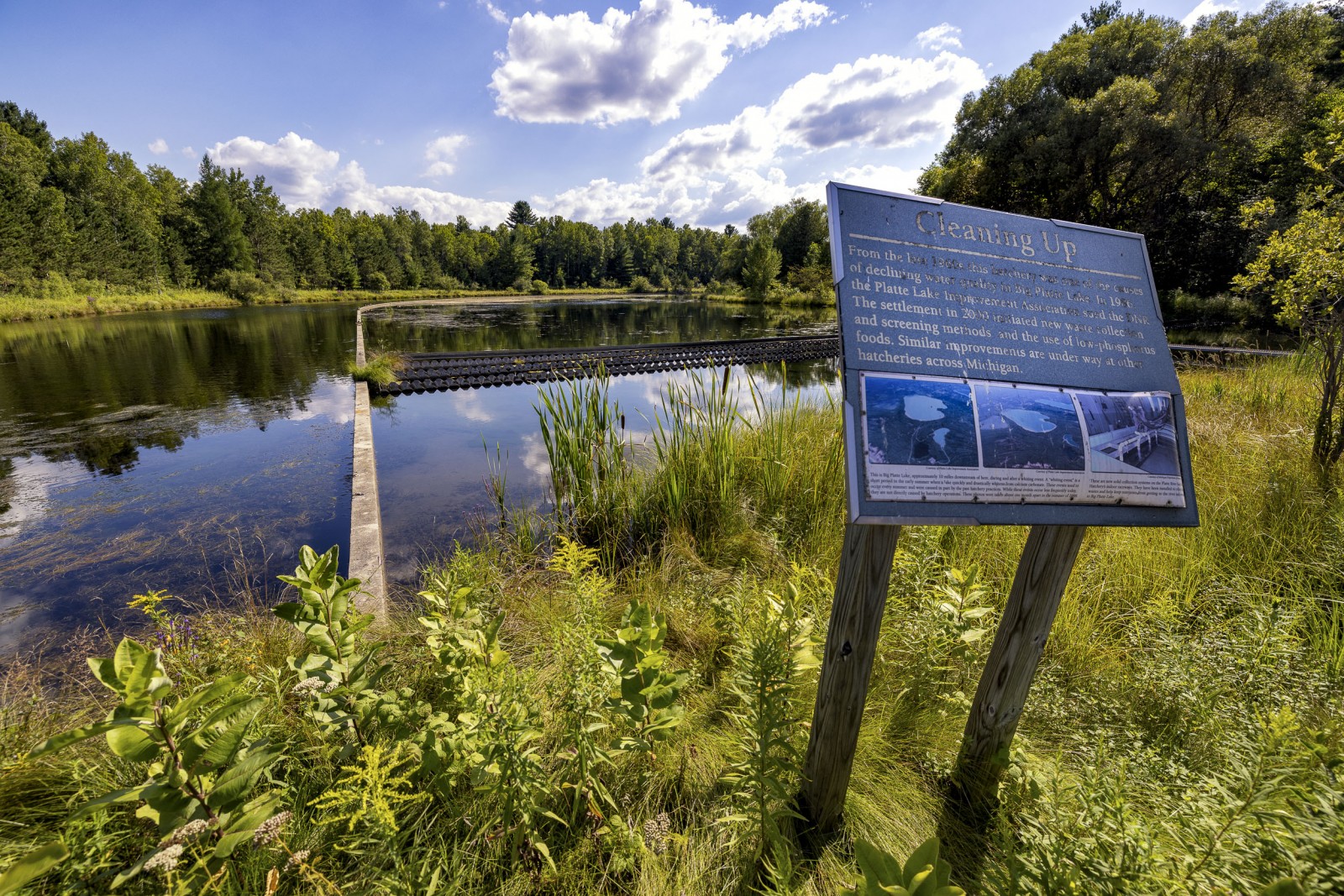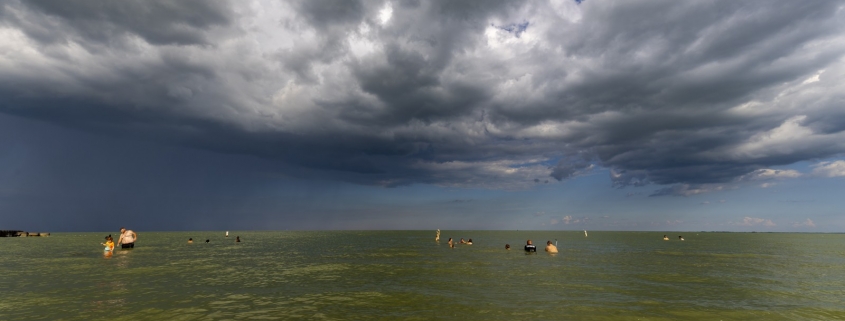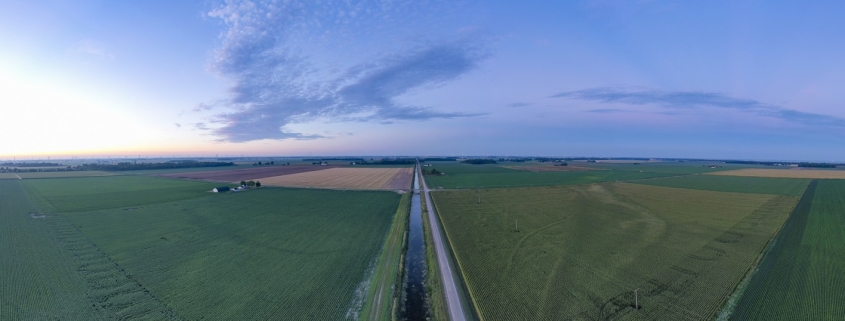 https://www.circleofblue.org/wp-content/uploads/2022/09/2022-08-19-Michigan-Thumb-JGanter-4852-Edit-2500.jpg
1067
1600
Keith Schneider
https://www.circleofblue.org/wp-content/uploads/2018/06/Circle-of-Blue-Water-Speaks-600x139.png
Keith Schneider2022-09-08 07:33:592023-02-02 15:08:49Danger Looms Where Toxic Algae Blooms
https://www.circleofblue.org/wp-content/uploads/2022/09/2022-08-19-Michigan-Thumb-JGanter-4852-Edit-2500.jpg
1067
1600
Keith Schneider
https://www.circleofblue.org/wp-content/uploads/2018/06/Circle-of-Blue-Water-Speaks-600x139.png
Keith Schneider2022-09-08 07:33:592023-02-02 15:08:49Danger Looms Where Toxic Algae BloomsRemedies for Harmful Algal Blooms Are Available in Law and Practice
They are expensive, in many cases experimental, and take a long time to work.
By Keith Schneider, Circle of Blue
Photography by J. Carl Ganter
September 27, 2022
Sixth in a six-part series. Read the first story here.
HONOR, Mich. – In 1974, when he was 27 years old, Wilfred Swiecki invited his Maltese-born fiancée to join him at the family cottage on Platte Lake in Benzie County. Though he’d been away for several years pursuing degrees in engineering, Swiecki anticipated showing her the same magnificent northern Michigan lake of his boyhood summers — waters teeming with bass and pike and so clear the deep lake bottom was plainly visible.
Swiecki’s return was a shock. Lake waters were green and filmy with algae. Swirls of blue-green algae and ugly algae mats floated on the surface. The air carried the scent of decay. “I couldn’t see my toes in three feet of water,” Swiecki recalled in an interview. “I said, ‘This is crazy.’ So I really got into it.”
With the help of other members of Platte Lake Improvement Association, plus a team of lawyers and scientists, Swiecki led a 48-year campaign that forced a state fish hatchery to sharply reduce its bloom-generating phosphorus discharges, an achievement that set enduring precedents in state environmental law, and restored the lake’s ecological condition. The association also built a state-of-the art water quality monitoring network across the lake’s 192 square-mile watershed. Its data, available online, provide real-time evidence to identify and squelch sources of phosphorus that would impair water quality.
In its simplest explanation, what occurred in this corner of northwest Michigan, some 300 miles from Lake Erie, is that Platte Lake’s citizen activists refused to be deterred. They relied on a lawsuit, peerless science, their own finances, and unyielding persistence to build a rare model –– in Great Lakes states and across the nation — for solving harmful algal blooms and ensuring they don’t return.
Platte Lake’s recovery is a useful reference for contending with harmful algal blooms anywhere in America, or in any other country. It provides irrefutable evidence that ending harmful blooms is possible. Just as relevant, it reveals how difficult achieving that goal is, how much it can cost, and how long it can take. As Swiecki and his partners learned, there is no mystery to solving harmful algal blooms. It is essential to stop phosphorus from reaching streams, rivers, and lakes, especially the dissolved phosphorus craved by cyanobacteria, the microorganisms that generate harmful blooms.
The tools and technology for achieving that goal in agriculture are well understood and applied with differing levels of authority, commitment, and effectiveness around the world, but not across the United States. China requires its large livestock operations to treat manure, in some cases with engineered wastewater treatment plants, before spreading livestock wastes on farmland. The Netherlands oversees strict requirements for storing, treating, and spreading manure to minimize polluting discharges. The country is establishing a circular economy for manure that involves separating, digesting, drying, and filtering nitrogen and phosphorus to produce a granular fertilizing product for replacing commercial fertilizer.
In the U.S., a potential solution is chemical technology to scrub harmful algal blooms from lakes. One company, BlueGreen Water Technologies, has developed floating granules from a proprietary formula of sodium percarbonate. Peroxide is the active ingredient. The granules are spread on the surface of lakes, killing cyanobacteria within 24 to 48 hours. Early results have indicated promising success. In 2019 the company applied its product to end a harmful bloom on Chippewa Lake in Ohio. Joanne Dodaro, the mayor of Chippewa Lake, told Circle of Blue the blooms have not returned.
The company treated Lake Minneola, west of Orlando, and proposes to apply its treatment to other lakes in Florida. The national environment departments in Canada and the U.S. have determined that when applied according to label instructions the treatments are safe for people and the environment. Both agencies found that within a few days of applying peroxide-based algaecides, peroxide breaks down to oxygen and water and leaves no long-term trace of the chemical.
For Platte Lake, the solution was controlling the source of contamination: the 94-year-old Platte River State Fish Hatchery in Honor, eight miles upstream. The federal Clean Water Act includes specific provisions to limit pollution from such “point sources” of contamination. But the Platte Lake advocates did not rely on federal law. They based their campaign on state law, the powerful Michigan Environmental Protection Act (MEPA), which gives citizens the right to protect all natural resources from “conduct” that is “likely to result in pollution, impairment, or destruction” from any source. That includes “non-point discharges” from farms, the primary cause of harmful algal blooms in the Great Lakes and across much of the country.
MEPA’s authority stems from its foundation in the Michigan Constitution that recognizes a “paramount” public interest in the state’s natural resources, and the public trust doctrine, a potent legal principle that dates to the Roman Empire and requires states to protect water and other natural resources for the public’s benefit. The Platte Lake case displayed the power of citizen lawsuits, MEPA, and the public trust doctrine to compel a polluter to halt damaging discharges.
In 2016, the International Joint Commission, a Canadian-American agency that oversees the Great Lakes Water Quality Agreement, called for U.S. states and Canadian provinces to apply public trust principles to safeguard Great Lakes basin waters. In short, citizens in Great Lakes states that lack powerful pollution prevention statutes comparable to MEPA could bring public trust doctrine cases in state courts to stop phosphorus discharges that cause harmful algal blooms.
“The solution to environmental and public health problems of this magnitude can’t be resolved by media campaigns and public meetings,” said James Olson, a prominent Michigan environmental lawyer and legal advisor to the Platte Lake campaign. “You have to get the stakeholders to the table under the compulsion of law. In the Platte Lake case MEPA and the public trust doctrine produced changes in practice that restored the lake.”
In applying state law to ending a harmful algal bloom, the Platte Lake Improvement Association joined a select group of governments, citizen groups, researchers, and private companies seeking to achieve the same result. From the Chesapeake Bay on the East Coast to Washington state’s Yakima Valley on the West Coast, and in the Great Lakes states in between, a range of novel strategies and tactics are being put to use to end harmful algal blooms.
What is especially notable is that the most successful strategies depart from agricultural orthodoxy advanced by agricultural universities, and the federal and state agriculture departments, which encourage farmers to apply more phosphorus on cropland than is needed to produce ample harvests. Algae fighters instead call for applying much less fertilizer, or no commercial fertilizer or livestock manure at all, on farmland that already contains high levels of phosphorus.
The strategies also differ markedly from the “best management practices” advocated by the federal and state agriculture departments, and agricultural land grant universities. Persistently high concentrations of dissolved reactive phosphorus in streams and rivers are clear evidence that farmers are applying too much phosphorus, livestock producers are spreading too much liquid manure, and so-called BMPs — buffer strips, no-till cultivation, cover crops, two-stage ditches and others — are not impeding dissolved phosphorus discharges from farm fields.

The Platte River Fish Hatchery relies on an engineered wetland to reduce phosphorus concentrations in water discharged to the river, and downstream to Platte Lake. Photo © J. Carl Ganter/ Circle of Blue
Cut Nutrient Applications
Researchers assert that solving harmful algal problems starts with understanding how dissolved phosphorus behaves and how little dissolved phosphorus is needed to stir big algal blooms. Progress, they say, begins by significantly altering how crop farms apply fertilizer and livestock producers manage manure.
A bit of science and agronomy is called for here. The first point is this: It takes scant increases in dissolved phosphorus — a few hundredths of a part per million in water above background levels, or a pound or two per acre, sometimes less — to cause cyanobacteria to grow out of control and form big harmful blooms.
The second point: Due to decades of fertilizer use, phosphorus concentrations in large expanses of Great Lakes soils already measure more than 40 parts per million, a level considered high for crop production. Michigan State University asserts that at least half of the state’s row crop farmland needs no additional phosphorus.
The third point: formal fertilizer recommendations made by agricultural universities still direct farmers in Michigan who want to produce a 200 bushel-per-acre corn crop to apply 70 pounds of phosphorus fertilizer on soil that contains phosphorus at 2o to 40 parts per million. In Ohio and Michigan, big livestock operations are allowed to apply billions of gallons of liquid manure, which contain substantial amounts of phosphorus, to fields with phosphorus levels up to 150 parts per million.
A fourth point: Farmers apply phosphorus fertilizer after the fall harvest when there is nothing growing in the fields, and plants are not taking up the nutrients. Livestock operations in Michigan apply liquid manure year-round, though they are discouraged from spreading in winter.
“You can see why we’re losing dissolved reactive phosphorus from fields,” said Chad Penn, a U.S. Department of Agriculture soil research scientist. “But the amount of dissolved phosphorus that’s being lost is inconsequential to the grower, and inconsequential to the crop. A pound, a few pounds per acre. It’s nothing. The crop is not going to miss it. But it’s devastating to water quality.”
The solution: change fertilizer recommendations to dramatically reduce or eliminate nutrient applications — and liquid manure spreading — on soils that already contain ample concentrations of phosphorus. In Lenawee County, in the Lake Erie watershed of southeast Michigan, Tom Van Wagner, a specialist in soils and forestry, is recruiting farmers to participate in multi-year projects that call for farmers not to apply any liquid manure or commercial fertilizer on soils that contain more than 10 parts per million phosphorus.
“Farmers are spending a lot of money on fertilizer that they don’t need,” Van Wagner said. “We’ve been overfertilizing for years.”

One of the nation’s rare successes in halting harmful algal blooms occurred on Platte Lake in northern Michigan when citizens filed a state lawsuit to dramatically cut phosphorus discharges from the Platte River State Fish Hatchery. Paul Stowe is its natural resources manager. Photo © J. Carl Ganter/ Circle of Blue
Phosphorus Traps
Another approach for keeping dissolved phosphorus out of ditches and streams is to direct farm runoff to constructed facilities where it will be absorbed. Two techniques are being tested in the Great Lakes region: phosphorus traps and engineered wetlands.
Chad Penn promotes phosphorus traps, which are essentially septic fields for farmland runoff.
The traps take advantage of well understood chemistry and engineering. First, soluble phosphorus binds to metals to form metal oxides. Second, it’s easy to build a subsurface structure and fill it with phosphorus-absorbing material, like steel shavings mixed with gravel.
Traps require some adjustment to the tiling and ditch networks installed in most Great Lakes farm fields in order to collect and direct drainage through the filter material. Soluble phosphorus clings to the metals and remains in the filter. Periodically, old filters needs to be replaced with fresh material.
Phosphorus traps are under development and in use in a number of applications on Great Lakes farms where they have shown to be very effective in stemming the flow of dissolved phosphorus. The cost to install varies with the size of the trap.
“They are engineered structures and will last as long as you design them,” Penn said. “Steel shavings mixed with gravel. That is the best media for the money. I have some structures that have been in place for years and are still working.”
Joseph Fenslau, general manager of Plant Tuff Inc., said his Michigan-based company installed four traps in Holland to control phosphorus discharges from large hog operations. The filtering material is slag from steel mills. “I can tell you, they really work,” Fenslau said.
The U.S. Environmental Protection Agency approved $1.7 million in grants this year to develop and test three phosphorus traps in Wisconsin’s Fox River watershed. The agency is scouting sites for traps in Ohio. Research data indicates the traps are capable of absorbing half the phosphorus that flows through them.
Researchers have found that the same levels of phosphorus absorption are possible from constructed wetlands, a tool that Ohio promotes with its three-year-old H2Ohio campaign to reduce phosphorus discharges into Lake Erie. Ohio is investing $91.7 million to restore, enlarge, or construct 88 wetlands to absorb phosphorus from 100,000 acres of farmland, most of it in the Western Lake Erie basin, according to state figures.
Two of the projects are in Mercer County, which has undertaken one of the most aggressive local government campaigns in the country to battle harmful algal blooms. The target of the 10-year-old campaign is broad, shallow Grand Lake St. Marys. The largest man-made lake in Ohio experienced a ruinous bloom in 2010 caused by phosphorus draining from 135 dairy, swine, poultry and crop farms into its 60,000-acre watershed.
As one of a lengthy list of bloom-fighting steps, Mercer County purchased shoreline land and established 750 acres of wetlands, according to Theresa Dirksen, the county’s agriculture and natural resources director who oversees the project. The county has 110 more acres under construction. Wetlands that filter water draining from creeks into the lake are removing 90 percent of the phosphorus, she said. The total cost of the wetland project is $10 million.
The state and the county, with farmer endorsement, approved new regulations that require nutrient management plans for farms that produce more than 100,000 gallons of liquid manure, or 350 tons of solid manure annually. Those farms also are required to build storage facilities capable of holding 120 days of waste, and are forbidden to spread wastes on farmland from December 15 to March 1, or any time the land is snow-covered or frozen.
Dirksen stated that the harmful blooms are still an annual occurrence in Grand Lake St. Mary’s, but their toxicity has decreased by two-thirds.
In collaboration with several farms, the county also was awarded grants to test a number of commercially available waste management systems to remove phosphorus from manure. One was an engineered system that separated and washed solids from the manure, then added lime to draw phosphorus out in the form of a calcium-phosphate precipitate. Liquid was pressed out of the precipitate to form a mass firm enough to transport out of the watershed for use as fertilizer.
A pilot-scale project last year treated 100,000 gallons of manure, about a quarter of the waste from a hog farm with 1,400 animals. Roughly 10 tons of calcium phosphate was produced and tested with fertilizer companies. The cost of the project: $200,000.
“We’ve done a lot of pilot projects with different technologies,” Dirksen said. “There are a lot of technologies out there that are available. They all work to capture phosphorus. The issue is to find the economic viability of those technologies on our small to medium size farms. Without help it’s just not feasible.”
Help could be on the way. As part of the Inflation Reduction Act enacted in August, Congress approved $18.05 billion to be spent on farmland conservation programs. That is almost equal to the $18.06 billion spent in the past five years under the 2018 Farm Bill. In other words, a much larger source of public money is now available to develop and construct waste management infrastructure to keep phosphorus from draining into rivers and lakes. Other infrastructure considered feasible for agriculture include on-farm waste treatment plants, or regional treatment plants that handle manure transported from individual farms by a network of pipelines.
Next year, Congress will debate and enact a new five-year Farm Bill. Congress should add phosphorus removal systems and treatment plants as projects eligible for funding. The cost share could be the same as the early Clean Water Act support to curb point source pollution from municipal wastewater treatment plants. The federal government paid 80 percent of that bill.
Sen. Debbie Stabenow, Michigan Democrat and chair of the Senate Agriculture Committee, said she was aware of phosphorus removal systems and noted that innovation grants are available to demonstrate they work. “We just passed the Inflation Reduction Act, which is going to provide major incentives for a broad range of practices and strategies for managing nutrients and guarding water quality,” Sen. Stabenow said.
She added:, “We’re directing the USDA to focus on those practices that deal with nutrients and runoff, and water quality.”
The 2023 farm legislation should also include new provisions to limit manure or fertilizer applications to soils that don’t need additional phosphorus. The provisions should require farmers to much more rigorously test soil. Such requirements could be attached to a farmer’s access to crop insurance and the subsidies available to pay for it. Most commercial farmers buy crop insurance to protect against bad weather or any other threat that reduces their production. Farmers who don’t agree to adopt the new pollution-control measures would lose the insurance subsidy.
“Crop insurance can be a way to leverage participation,” said Tom Van Wagner, with the Lenawee County Conservation District. “Everybody’s in crop insurance now. If you don’t get crop insurance, you can’t get your subsidies, you can’t afford to farm.”

Once polluted by high concentrations of phosphorus that produced miserable toxic algae blooms, Platte Lake is now a magnificent expanse of clean and clear fresh water. Photo © J. Carl Ganter/ Circle of Blue
Lawsuits Are Effective
Across the landscape of rare successes in curbing phosphorus pollution, few strategies have been more difficult, or more effective, than filing lawsuits.
In Washington State’s Yakima Valley, two non-profits, one local and the other national, collaborated to sue Cow Palace and four other dairies in 2013 for mismanaging manure and polluting drinking water. The non-profits brought the case under provisions of the Resource Conservation and Recovery Act (RCRA), the federal law that oversees management of solid and hazardous wastes. U.S. District Court Judge Thomas Rice ruled in 2015 that manure was a solid waste and that its reckless application, storage, and management at the Cow Palace Dairy violated the federal law’s prohibitions on imminent endangerment and open dumping.
The dairy, with 11,000 animals in its care, was later directed to institute remedial steps to prevent harm to health and the environment. The case opened opportunities to sue other large dairies in the Yakima Valley to halt non-point discharges of pollutants. Dairies were required to monitor groundwater, test soil to prevent manure spreading on land with elevated levels of nutrients, and line their waste lagoons to prevent leaks. Among other measures to prevent water contamination, farms are prohibited from spreading manure on frozen ground.
Three more Yakima Valley farms have been sued or agreed to comply with the safeguards. Several more dairies are in the process of coming into compliance. Adherence to the RCRA-imposed safety measures now encompass 55,000 cows, or half of Yakima Valley’s dairy herd.
“This is could be replicated anywhere,” said Amy van Saun, who as a senior attorney with the national non-profit advocacy group Center For Food Safety helped litigate the original 2013 lawsuit and ongoing cases. “You need the data to show the polluter, in this case the dairy, is contributing to the problem. That’s groundwater testing. In the Yakima Valley the problem had been going on so long. With community advocacy the EPA finally came in and did a big study and determined that, in fact, it was the dairies that caused groundwater pollution.”

Wilfred Swiecki was 27 years old when he helped to launch and later lead the 48-year citizen campaign to cure Platte Lake of harmful algal blooms. Photo © J. Carl Ganter/ Circle of Blue
Chesapeake Bay
Another example of deploying the law to reduce nutrient discharges is unfolding on the East Coast. In 2009, after years of advocacy that attracted insufficient government attention, the Chesapeake Bay Foundation sued the EPA to enforce the Clean Water Act and end nutrient discharges that were causing harmful blooms in the bay. The suit was settled a year later, but not before President Obama issued an executive order that established a federal interagency committee to organize and lead the cleanup.
As part of the settlement, the EPA set limits on nitrogen, phosphorus, and sediment that fouled the bay. The six states in the bay watershed, and Washington, D.C., agreed to develop individual cleanup plans, decided on steps to reduce discharges, and set milestones to have practices in place to achieve 60 percent of the reductions by 2017, and all of the EPA-designated water pollution limits by 2025.
The negotiated agreement helped deliver the largest, most comprehensive, and most expensive coordinated federal and state effort to limit nutrient discharges, clear nutrient pollution, and restore one of the nation’s major water bodies. Federal and state spending on the agreement’s objective has totaled $17.4 billion over the last seven years, much of it to upgrade wastewater treatment plants, according to the federal Office of Management and Budget.
The effect of the project on the bay’s restoration is mixed, according to the latest progress reports prepared by federal agencies and the Chesapeake Bay Foundation. Upgrading wastewater treatment plants lowered discharges of phosphorus and nitrogen. Seagrass beds are expanding in certain areas. The agreement called for permanently protecting two million acres of forests, wetlands, and other natural landscapes by 2025 to slow drainage and absorb nutrients. Some 1.4 million acres have been conserved, according to ChesapeakeProgress, a tracking system coordinated by the EPA.
But achieving the agreement’s water quality goals by 2025 appears to be out of reach. There are, for instance, still no healthy watersheds in Delaware, where large poultry operations are the source of excess manure and major phosphorus and nitrogen discharges into streams. The number of adult female blue crabs declined 61 percent since 2017. Pennsylvania does not have an approved cleanup plan, and its intense dairy sector continues to be an immense source of manure that drains phosphorus into the Susquehanna River and the Chesapeake Bay. Algal blooms persist, as does an oxygen-deprived dead zone caused by excess nutrients, principally from crop and livestock farms.
“Efforts to reduce pollution from agriculture and urban and suburban runoff must accelerate—especially in Pennsylvania, which remains far off track largely due to a lack of resources to help farmers implement conservation practices,” the Chesapeake Bay Foundation noted in a 2020 assessment.
“We have hotspots in the watershed. South central Pennsylvania. The eastern shore of Maryland and Delaware. The Shenandoah Valley in Virginia,” added Beth McGee, the foundation’s director of science and agricultural policy. “Those are where we raise a lot of animals, and where a lot of our nutrients are coming from. It’s the biggest source for both nitrogen and phosphorus.”

One of the nation’s rare successes in halting harmful algal blooms occurred on Platte Lake in northern Michigan when citizens filed a state lawsuit to dramatically cut phosphorus discharges from a state fish hatchery. Photo © J. Carl Ganter/ Circle of Blue
Michigan’s Powerful Environmental Law
The Platte Lake cleanup is more proof of the usefulness of a legal strategy to end phosphorus discharges. In this case, deploying the Michigan Environmental Protection Act, arguably the most powerful state environmental law in the nation.
MEPA, as it’s commonly known, gives state courts the authority to prevent conduct that causes “pollution, impairment, or destruction” unless “there is no feasible and prudent alternative.” The Platte Lake Improvement Association identified the hatchery as the primary polluter, phosphorus as the offending pollutant, and made the case for the lake’s severe impairment and destruction. The association also showed the Platte River hatchery had feasible and prudent alternatives, like changing to a low-phosphorus brand of fish food, and adding waste water treatment infrastructure that dramatically reduced phosphorus discharges.
While straightforward in its narrative, the story has unfolded in chapters spanning decades.
It took 12 years from when Will Swiecki first got involved in 1974, to the decision by the lake association to file suit in 1986. Even after a state judge ruled in the association’s favor in 1988, it took another 12 years of fraught negotiations to develop the scientific database that resulted in the 2000 consent agreement to limit phosphorus discharges to 150 pounds annually. It took the DNR five more years to complete the hatchery upgrades in 2005 at a cost of $8.5 million.
The work by Swiecki and the lake association produced enduring benefits for Platte Lake aside from clean and clear water. It also established an exceptional program of citizen oversight to protect the lake and its watershed from new sources of phosphorus contamination. The association’s case turned on water quality data continuously sampled from sites across the watershed. Those sample results, collected and analyzed every week for 40 years, are now available in a digitized online database that serves as a contemporary sentinel for discovering and shutting off phosphorus discharges that would diminish Platte Lake’s clean water.
“Ours is an ongoing consent judgment with the DNR,” said Swiecki. “As long as we maintain a viable organization, that consent judgment continues. There’s a dispute resolution process. There’s a penalty fund if there are violations.
“You realize,” he added. “I was a young man when this started.” In August, Will Swiecki celebrated his 75th birthday.
Project credits:
This project was made possible by the Fred A. and Barbara M. Erb Family Foundation, and the Joyce Foundation.
Krystina Hird served as a researcher for this project. Hird is a PhD candidate in the Biochemistry and Molecular Biology program at MSU. Her research project focuses on understanding the mechanism of reducing nitrite to ammonium via bacterial cytochrome c nitrite reductase.
Dr. Laura T. Johnson, director of the National Center for Water Quality Research at Heidelberg University, served as a science advisor for this project.
Read the full series here
 https://www.circleofblue.org/wp-content/uploads/2022/09/2022-08-19-Michigan-Thumb-JGanter-4852-Edit-2500.jpg
1067
1600
Keith Schneider
https://www.circleofblue.org/wp-content/uploads/2018/06/Circle-of-Blue-Water-Speaks-600x139.png
Keith Schneider2022-09-08 07:33:592023-02-02 15:08:49Danger Looms Where Toxic Algae Blooms
https://www.circleofblue.org/wp-content/uploads/2022/09/2022-08-19-Michigan-Thumb-JGanter-4852-Edit-2500.jpg
1067
1600
Keith Schneider
https://www.circleofblue.org/wp-content/uploads/2018/06/Circle-of-Blue-Water-Speaks-600x139.png
Keith Schneider2022-09-08 07:33:592023-02-02 15:08:49Danger Looms Where Toxic Algae Blooms
Farms in Six Southeast Michigan Counties Are Major Sources of Lake Erie Toxic Blooms

In A Year of Water Quality Reckoning, National Imperative is Impeded

Lake Erie’s Failed Algae Strategy Hurts Poor Communities the Most

Powerful Industry’s Torrent of Manure Overwhelms State Regulators
A new documentary explores the issue and helps residents of the region understand what’s a stake and what possible solutions could be.
Circle of Blue’s senior editor and chief correspondent based in Traverse City, Michigan. He has reported on the contest for energy, food, and water in the era of climate change from six continents. Contact
Keith Schneider
Related
© 2025 Circle of Blue – all rights reserved
Terms of Service | Privacy Policy





